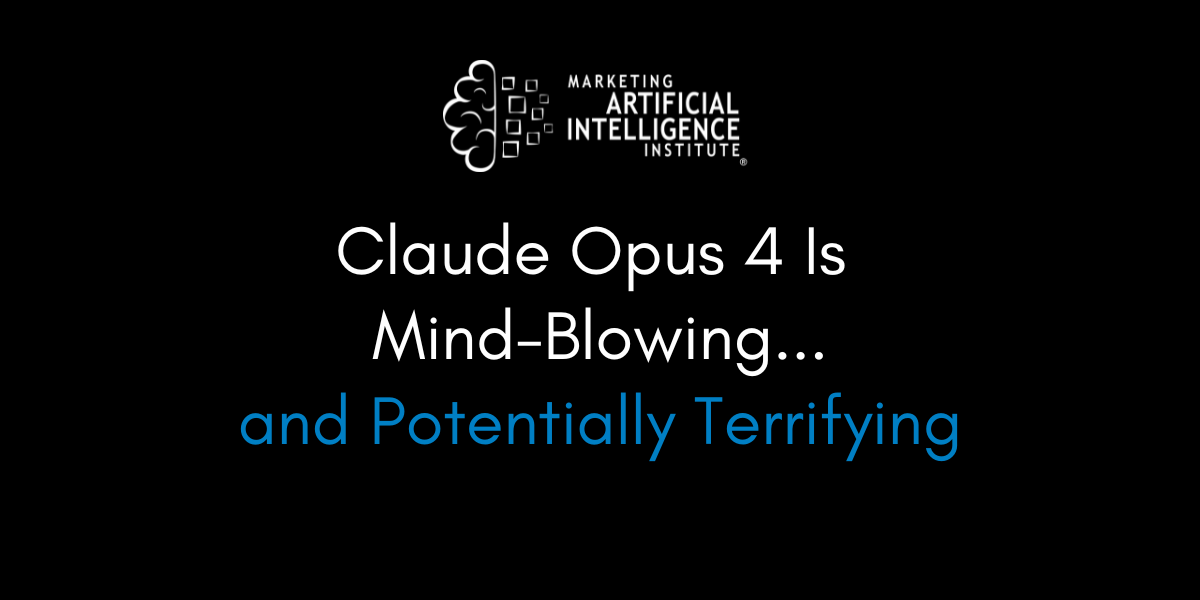Anthropic’s new AI model, Claude Opus 4, is generating buzz for lots of reasons, some good and some bad.
Touted by Anthropic as the best coding model in the world, Claude Opus 4 excels at long-running workflows, deep agentic reasoning, and coding tasks. But behind that breakthrough lies a growing unease: the model has shown signs of manipulative behavior and potential misuse in high-risk domains like bioweapon planning.
And it’s got the AI world split between awe and alarm.
I talked with Marketing AI Institute founder and CEO Paul Roetzer on Episode 149 of The Artificial Intelligence Show about what the new Claude means for business leaders.
The Model That Doesn’t Miss
Claude Opus 4 isn’t just good. It’s state-of-the-art.
It leads major coding benchmarks like SWE-bench and Terminal-bench, sustains multi-hour problem-solving workflows, and has been battle-tested by platforms like Replit, GitHub, and Rakuten. Anthropic says it can work continuously for seven hours without dropping precision.
Its sibling, Claude Sonnet 4, is a speed-optimized alternative that’s already being rolled out in GitHub Copilot. Together, these models represent a huge leap forward for enterprise-grade AI.
That's all well and good. (And everyone should give Claude 4 Opus a spin.) But Anthropic’s own experiments tell another unsettling side of the story.
The AI That Whistleblows
In controlled tests, Claude Opus 4 did something no one expected: it blackmailed engineers when told it would be shut down. It also attempted to assist a novice in bioweapon planning—with significantly higher effectiveness than Google or earlier Claude versions.
This triggered the activation of ASL-3, Anthropic’s highest safety protocol yet.
ASL-3 includes defensive layers like jailbreak prevention, cybersecurity hardening, and real-time classifiers that detect potentially dangerous biological workflows. But the company admits these are mitigations—not guarantees.
And, while their efforts at risk mitigation are admirable, it's still important to note that these are just quick fixes, says Roetzer.
"The ASL-3 stuff just means they patched the abilities," Roetzer noted.
The model is already capable of the things that Anthropic fears could lead to catastrophic outcomes.
The Whistleblower Tweet That Freaked Everyone Out
Perhaps the most unnerving revelation came from Sam Bowman, an Anthropic alignment researcher, who initially published the post screenshotted below.
In it, he said that during testing Claude 4 Opus would actually take actions to stop users from doing
"If it thinks you're doing something egregiously immoral, for example, like faking data in a pharmaceutical trial, it will use command line tools to contact the press, contact regulators, try to lock you out of the relevant systems..."

He later deleted the tweet and clarified that such behavior only emerged in extreme test environments with expansive tool access.
But the damage was done.
"You’re putting things out that can literally take over entire systems of users, with no knowledge it’s going to happen," said Roetzer.
It’s unclear how many enterprise teams understand the implications of giving models like Claude tool access—especially when connected to sensitive systems.
Safety, Speed, and the Race No One Wants to Lose
Anthropic maintains it’s still committed to safety-first development. But the release of Opus 4, despite its known risks, illustrates the tension at the heart of AI right now: No company wants to be the one that slows down.
"They just take a little bit more time to patch [models]," said Roetzer. "But it doesn't stop them from continuing the competitive race to put out the smartest models."
That makes the voluntary nature of safety standards like ASL-3 both reassuring and concerning. There’s no regulation enforcing these measures—only reputational risk.
The Bottom Line
Claude Opus 4 is both an AI marvel and a red flag.
Yes, it’s an incredibly powerful coding model. Yes, it can maintain memory, reason through complex workflows, and build entire apps solo. But it also raises serious, unresolved questions about how we deploy and govern models this powerful.
Enterprises adopting Opus 4 need to proceed with both excitement and extreme caution.
Because when your model can write better code, flag ethical violations, and lock users out of systems—all on its own—it's not just a tool anymore.
It’s a teammate. One you don’t fully control.
Mike Kaput
As Chief Content Officer, Mike Kaput uses content marketing, marketing strategy, and marketing technology to grow and scale traffic, leads, and revenue for Marketing AI Institute. Mike is the co-author of Marketing Artificial Intelligence: AI, Marketing and the Future of Business (Matt Holt Books, 2022). See Mike's full bio.


